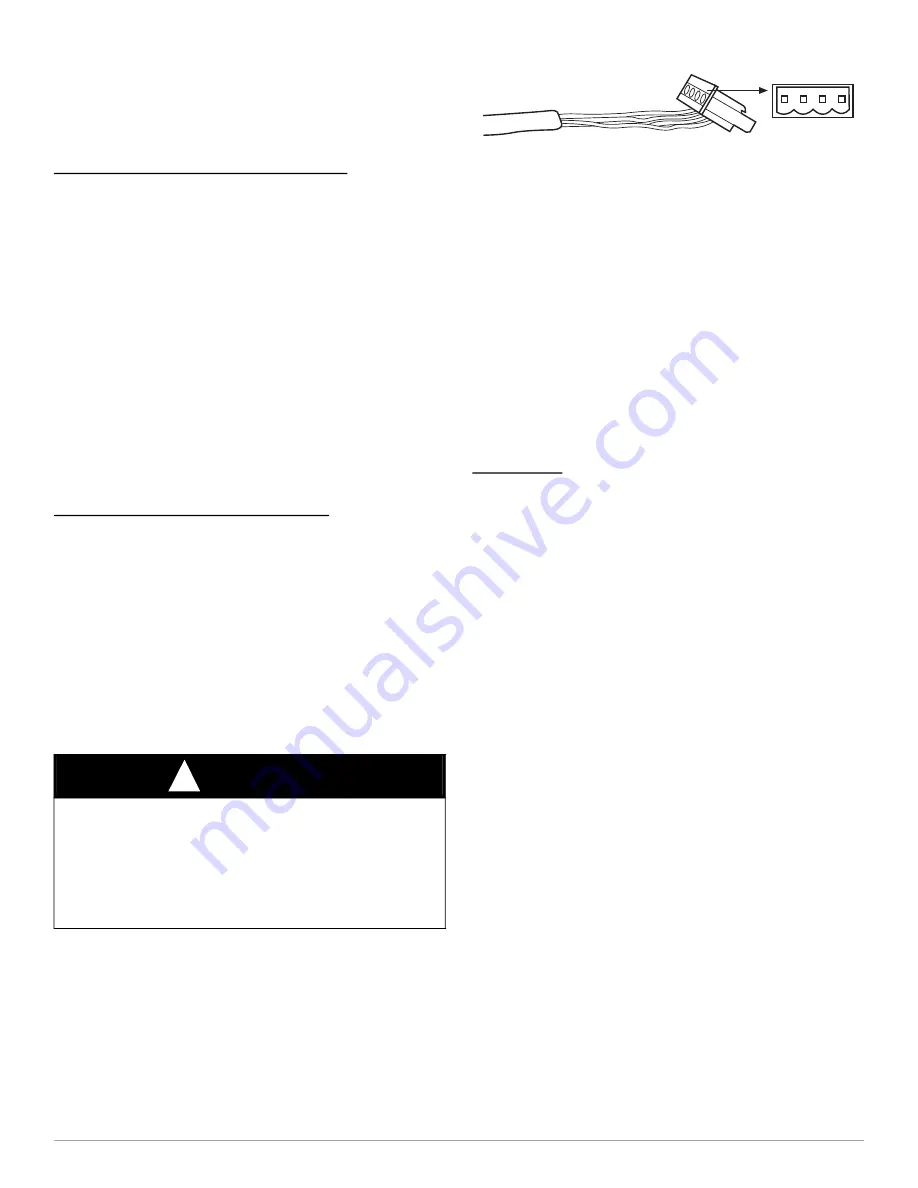
F97CMN and G97CMN: Installation, Start-up, Operating and Service and Maintenance Instructions
Manufacturer reserves the right to change, at any time, specifications and designs without notice and without obligations.
28
7. Install the green ground screw to the J-Box bracket and attach both
ground wires to the green ground screw.
8. Connect any code required external disconnect(s) to field power
wiring.
9. Connect field power and neutral leads to furnace power leads inside
the external electrical box as shown in
.
Power Cord Installation in Furnace J-Box
NOTE:
Power cords must be able to handle the electrical requirements
. Refer to power cord manufacturer’s listings.
1. Install J-Box mounting bracket to inside of furnace casing, see
.
2. Route listed power cord through 7/8-in. (22 mm) diameter hole in
casing and J-Box bracket.
3. Secure power cord to J-Box bracket with a strain relief bushing or a
connector approved for the type of cord used.
4. Pull furnace power wires through 1/2-in. (12 mm) diameter hole in
J-Box. If necessary, loosen power wires from strain—relief wire-tie
on furnace wiring harness.
5. Connect field ground wire and factory ground wire to green ground
screw on J-Box mounting bracket as shown in
6. Connect power cord power and neutral leads to furnace power leads
.
7. Attach furnace J-Box cover to mounting bracket with screws
supplied in loose parts bag. Do not pinch wires between cover and
.
BX Cable Installation in Furnace J-Box
1. Install J-Box mounting bracket to inside of furnace casing, see
.
2. Route BX connector through 7/8-in. (22 mm) diameter hole in
casing and J-Box bracket.
3. Secure BX cable to J-Box bracket with connectors approved for the
type of cable used.
4. Connect field ground wire and factory ground wire to green ground
screw on J-Box mounting bracket as shown in
5. Connect field power and neutral leads to furnace power leads. as
shown in
6. Attach furnace J-Box cover to mounting bracket with screws
supplied in loose parts bag. Do not pinch wires between cover and
bracket.
Communication Connector is used when the furnace is controlled by an
optimum communicating User Interface, see
The communication plug is supplied with the User Interface. Refer to the
instructions supplied with the User Interface.
A03193
Fig. 35 – Communication Connector
NOTE:
A = DX+, B = DX-, C = C, D = R
Outside Air Thermistor (OAT)
Used in conjunction with communicating User Interface. Not required
when a standard type thermostat is used. Refer to the instructions
supplied with the User Interface for details.
24-V Wiring
Make field 24-v connections at the 24-v terminal strip, see
Connect terminal Y/Y2 as shown in
Use only AWG No. 18, color-coded, copper thermostat wire.
NOTE:
Use AWG No. 18 color-coded copper thermostat wire for
lengths up to 100 ft. (31 M). For wire lengths over 100 ft., use AWG No.
16 wire.
The 24-v circuit contains an automotive-type, 3-amp. fuse located on the
control. Any direct shorts during installation, service, or maintenance
could cause this fuse to blow. If fuse replacement is required, use ONLY
a 3-amp. fuse of identical size, see
Thermostats
For best results, use a communicating wall control to control this
modulating furnace. A single stage or two-stage heating and cooling
thermostat can be used with the furnace. The furnace control board CPU
will control the furnace and outdoor unit staging. A two stage heating
and cooling thermostat can also be used to control the staging. However,
full modulating capability will not be available when the furnace staging
is controlled by the thermostat. Furnace staging will be limited to
Minimum and Maximum inputs or Intermediate and Maximum inputs
depending on the configuration of set-up switches SW1-2 and SW4-2.
For two stage thermostat control of a 2-stage outdoor unit, remove the
ACRDJ jumper from the furnace control board. Refer to typical
thermostat wiring diagrams and the Sequence of Operation section for
additional details. Consult the thermostat installation instructions for
specific information about configuring the thermostat, see
WARNING
!
FIRE, EXPLOSION, ELECTRICAL SHOCK, AND
CARBON MONOXIDE POISONING HAZARD
Failure to follow this warning could result in dangerous operation,
personal injury, death, or property damage.
Do not drill into blower shelf of furnace to route control wiring. Route
any control or accessory wiring to the blower compartment through
external knockouts on the casing.
A
B
C
D
















































